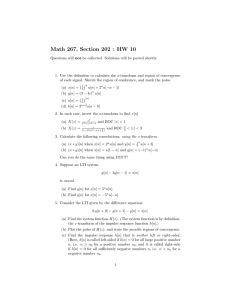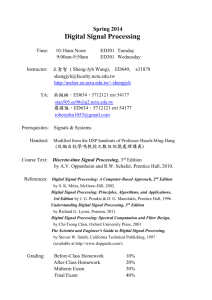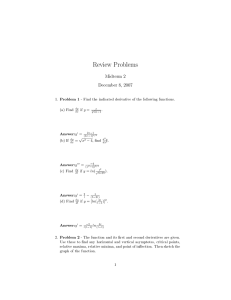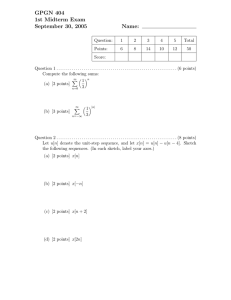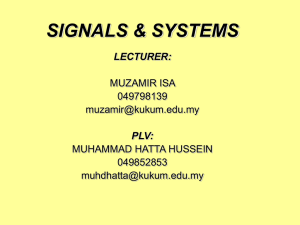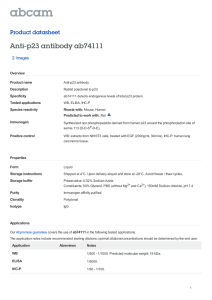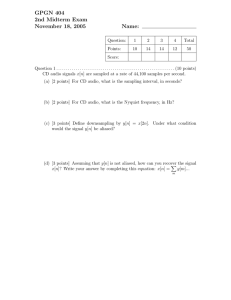23 Mapping Continuous-Time Filters Recommended Problems
advertisement
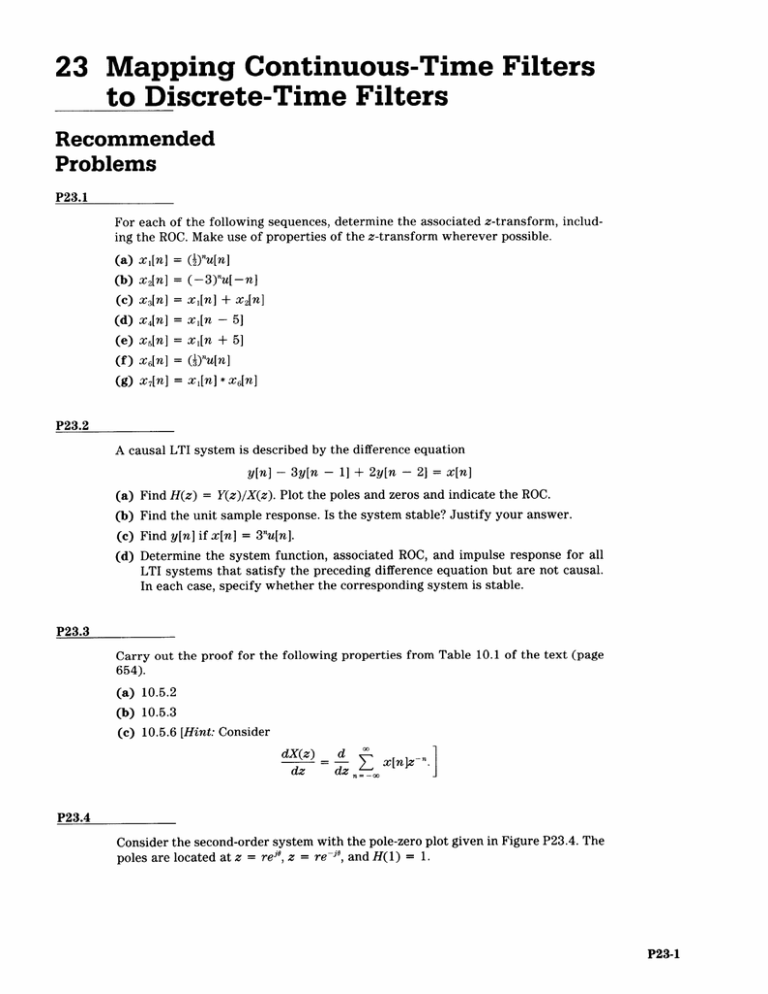
23 Mapping Continuous-Time Filters
to Discrete-Time Filters
Recommended
Problems
P23.1
For each of the following sequences, determine the associated z-transform, includ­
ing the ROC. Make use of properties of the z-transform wherever possible.
(a) x1[n] = (I)"u[n]
(b) X2[n] = (-3)"u[-n]
(c) xsn] = xi[n] + x2[n]
(d) X4[n] = xl[n -
5]
(e) x5[n] = xi[n + 51
(f)
eX[n] = (I)"u[n]
(g) x 7[n] = xi[n] * x 6 [n]
P23.2
A causal LTI system is described by the difference equation
y[n] - 3y[n -
1] + 2y[n - 2] = x[n]
(a) Find H(z) = Y(z)/X(z). Plot the poles and zeros and indicate the ROC.
(b) Find the unit sample response. Is the system stable? Justify your answer.
(c) Find y[n] if x[n] = 3"u[n].
(d) Determine the system function, associated ROC, and impulse response for all
LTI systems that satisfy the preceding difference equation but are not causal.
In each case, specify whether the corresponding system is stable.
P23.3
Carry out the proof for the following properties from Table 10.1 of the text (page
654).
(a) 10.5.2
(b) 10.5.3
(c) 10.5.6 [Hint: Consider
dX(z) dz
x
dzn=-_
n
]
P23.4
Consider the second-order system with the pole-zero plot given in Figure P23.4. The
poles are located at z = re", z = re- ", and H(1) = 1.
P23-1
Signals and Systems
P23-2
Im
z plane
/ r \
Re
Figure P23.4
(a) Sketch |H(e'")I as 0 is kept constant at w/ 4 and with r = 0.5, 0.75, and 0.9.
(b) Sketch H(ein) as r is kept constant at r = 0.75 and with 0 = r/4, 27r/4, and
37r/ 4.
P23.5
Consider the system function
H(z)
=z
(Z -
=
)(z -
2)
(a) Sketch the pole-zero locations.
(b) Sketch the ROC assuming the system is causal. Is the system stable?
(c) Sketch the ROC assuming the system is stable. Is the system causal?
(d) Sketch the remaining possible ROC. Is the corresponding system either stable or
causal?
P23.6
Consider the continuous-time LTI system described by the following equation:
d 2 y(t)
dy(t) dx(t)
+5
+6ytt)=x(t)+2 d
dt2
dt dt
(a) Determine the system function He(s) and the impulse response he(t).
(b) Determine the system function Hd(z) of a discrete-time LTI system obtained
from He(s) through impulse invariance.
(c) For T = 0.01 determine the impulse response associated with Hd(z), hd[n].
(d) Verify that hd[n] = hc(nT) for all n.
Mapping Continuous-Time Filters to Discrete-Time Filters / Problems
P23-3
Optional
Problems
P23.7
Consider a continuous-time LTI filter described by the following differential
equation:
dy(t) + 0.5y(t) = x(t)
dt
A discrete-time filter is obtained by replacing the derivative by a first forward dif­
ference to obtain the difference equation
y[n + 1]
T
-
y[n] + 0.5y[n] = x[n]
Assume that the resulting system is causal.
(a) Determine and sketch the magnitude of the frequency response of the continu­
ous-time filter.
(b) Determine and sketch the magnitude of the frequency response of the discretetime filter for T = 2.
(c) Determine the range of values of T (if any) for which the discrete-time filter is
unstable.
P23.8
Consider an even sequence x[n] (i.e., x[n] = x[-n]) with rational z-transform X(z).
(a) From the definition of the z-transform show that
(1)
Xz) = X
(b) From your result in part (a), show that if a pole (or a zero) of X(z) occurs at
z = zo, then a pole (or a zero) must also occur at z = 1/zo.
(c) Verify the result in part (b) for each of the following sequences:
+ 1] + b[n - 11
(i
b[n
(ii) 6[n + 1] - !Rkn] + b[n - 1]
(d) Consider a real-valued sequence y[n] with rational z-transform Y(z).
(i) (ii) Show that Y(z) = Y*(z*).
From part (i) show that if a pole (or a zero) of Y(z) occurs at z = zo, then
a pole (or a zero) must also occur at z = z*.
(e) By combining your result in part (b) with that in part (d), show that for a real,
even sequence, if there is a pole (or a zero) of H(z) at z = pej", then there is also
a pole (or a zero) of H(z) at z = pe-j", at z = (1/p)e'", and at z = (1/p)e -".
Signals and Systems
P23-4
P23.9
In Section 10.5.5 of the text we stated the convolution property for the z-transform.
To prove this property, we begin with the convolution sum expressed as
x 3 [n] = x 1 [n] * x 2[n]
=
x 1 [k]x2[n - k]
E
(P23.9-1)
k= -o
(a) By taking the z-transform of eq. (P23.9-1) and using eq. (10.3) of the text (page
630), show that
XA(z) =
x1[k]X 2(z),
k= -o0
where X 2(z) = Z{x2[n - k]}.
(b) Using the result in part (a) and the time-shifting property of z-transforms, show
that
x1[k]z­
XA(z) = X 2(z)
k=-o
(c) From part (b), show that
XA(z) = X 1(z)X 2(z).
P23.10
Consider a signal x[n] that is absolutely summable and its associated z-transform
X(z). Show that the z-transform of y[n] = x[n]u[n] can have poles only at the poles
of X(z) that are inside the unit circle.
P23.11
Let hc(t), sc(t), and He(s) denote the impulse response, step response, and system
function, respectively, of a continuous-time, linear, time-invariant filter.
Let hd[n], sd[n], and Hd(z) denote the unit sample response, step response, and
system function, respectively, of a discrete-time, linear, time-invariant filter.
(a) If hd[n]
=
hc(nT), does
2
Sd[n] =
hc(kT)?
k=
(b) If Sd[n]
=
sc(nT), does hd[n]
=
hc(nT)?
P23.12
Consider a continuous-time filter with input xc(t) and output yc(t) that is described
by a linear constant-coefficient differential equation of the form
dk yc(0
N
=0
a
k
M
(k=O bk
dkxc(t) dtk
(P23.12-i)
Mapping Continuous-Time Filters to Discrete-Time Filters / Problems
P23-5
The filter is to be mapped to a discrete-time filter with input x[n] and output y[n]
by replacing derivatives with central differences. Specifically, let V("k{x[n]} denote
the kth central difference of x[n], defined as follows:
V(43{x[n]} = x[n]
V('[x[n]}
V(k){xln]}
x[n + 1]
-
x[n
-
1]
V(l){V(k-'){x[nJ}}
The difference equation for the digital filter obtained from the differential equation
(P23.12-1) is then
N
M
E
akV k){y[n])
k=O
=
Z bkV(k){x[nI}
k=0
(a) If the transfer function of the continuous-time filter is Hc(s) and if the transfer
function of the corresponding discrete-time filter is Hd(z), determine how Hd(z)
is related to He(s).
(b) For the continuous-time frequency response He(jw), as indicated in Figure
P23.12-1, sketch the discrete-time frequency response Hd(ej0 ) that would result
from the mapping determined in part (a).
2
-
2
4
Figure P23.12
(c) Assume that Hc(s) corresponds to a causal stable filter. If the region of conver­
gence of Hd(z) is specified to include the unit circle, will Hd(z) necessarily cor­
respond to a causal filter?
P23.13
In discussing impulse invariance in Section 10.8.1 of the text, we considered Hc(s)
to be of the form of eq. (10.84) of the text with only first-order poles. In this problem
we consider how the presence of a second-order pole in eq. (10.84) would be
reflected in eq. (10.87) of the text. Toward this end, consider Hc(s) to be
He(s)
A
(S - so)2
(a) By referring to Table 9.2 of the text (page 604), determine hc(t). (Assume
causality.)
Signals and Systems
P23-6
(b) Determine hd[n] defined as hd[n] = hc(nT).
(c) By referring to Table 10.2 of the text (page 655), determine Hd(z), the z-trans­
form of hd[n].
(d) Determine the system function and pole-zero pattern for the discrete-time sys­
tem obtained by applying impulse invariance to the following continuous-time
system:
He(s)
=
1
(s + 1)(s + 2)2
MIT OpenCourseWare
http://ocw.mit.edu
Resource: Signals and Systems
Professor Alan V. Oppenheim
The following may not correspond to a particular course on MIT OpenCourseWare, but has been
provided by the author as an individual learning resource.
For information about citing these materials or our Terms of Use, visit: http://ocw.mit.edu/terms.

